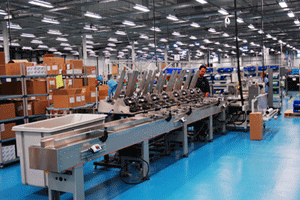Color affects mood and perception. It’s amazing how a slight change in color can alter the look and feel of a room. I found this out first-hand recently after doing a little painting at home.
little painting at home.
Whenever I step into an assembly plant, I always try to take a quick look at the color of its floor, walls and equipment. Usually, it’s nothing to get too excited about.
However, several years ago, when I set foot inside a medical device plant, I was blown away by what I saw. The floor was painted an unusual shade of blue (I expected to see a dull shade of gray or white). It was a sharp, refreshing color that made the plant bright and lively.
Color can also send a message when it’s creatively used on machine tools and assembly equipment. For instance, to raise awareness of breast cancer research efforts, several equipment suppliers recently produced some machines and components painted in a pink hue.
According to a new book called The Color Revolution (MIT Press), “the layouts of factories and the design of machines are subject to changing fashions.” Back in the early 1920s, “mill white became the preferred paint for clean factories, and people forgot about the Victorian tradition of colorized machinery,” says author Regina Lee Blaszczyk.
Around that same time, “widespread electrification led to workers’ complaints about glare and sparked a new interest in color,” Blaszczyk points out. “Plant managers found that repainting the plain black machinery in bright, pleasant enamels reduced eyestrain, restlessness and errors at the workbench. They also began to use color-coded paint systems as an aid to factory safety.
“After the stock market crash of 1929, more and more factories colorized machinery as a means to improve their public image, their safety records and their production output,” adds Blaszczyk.
The book also offers insight into how color played a key role in product design at General Motors in the 1920s and Maytag in the 1930s. I didn’t know that once upon a time, most washing machines were light gray (white didn’t become the standard color until the early 1940s).
Do you think color still matters on the plant floor? Does your facility have any equipment, floors or walls painted unusual colors?
Does Color Matter on the Plant Floor?


Recent Comments
Helpful for Trainees
Cable Assembly Manufacturers
Huawei for manufacturing?
should have a scanner and then 3D print the repair
IPC-A-610 and IPC-j-std-001